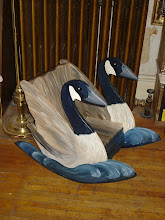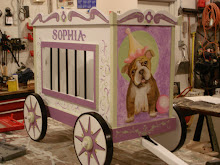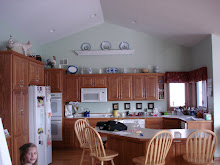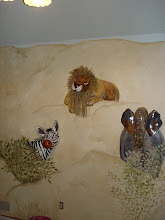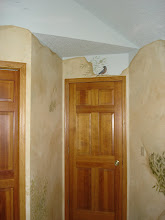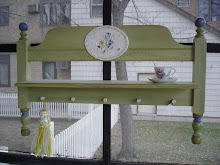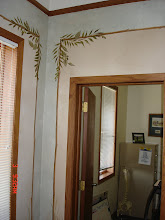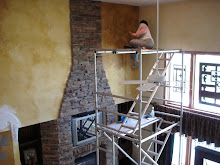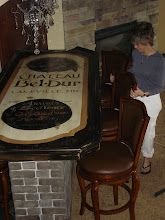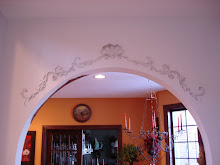These are pretty simple, but time consuming. I made most of my set of 16 (so far) several years ago, inspired by the first Harry Potter book, to create some witchy whimsy in my kitchen. Every few years I get around to adding another. My friends Mary and Kit have both been after me to teach this as a class, so at our last (literally last, but that's a happy story for next week) Second Saturday Soup & Studio gathering, I pulled out the supplies.
To paint these jars, I use Pebeo Porcelaine paints and outliners. Pebeo makes several other paints, all packaged in the same type of bottle, so be sure to read the label. Porcelaine used to be commonly sold at craft stores, but lately I've only been finding it at (Dick) Blick Art Materials. If you cannot find them at your local art supply store, find them online by clicking here: Pebeo at Blick Blick recommends soft natural brushes, like those used for water color. I've had good results with brushes designed for decorative painting with acrylics, as well. You will want a one half inch wide, flat one for covering large areas, and a few small flat and round tipped brushes for painting checks, dots, and small areas.
For my jars, I chose a mix of magical colors, including Olivine, Amber, Turquoise, Garnet Red (plummy magenta), Amethyst Purple, and white (for some labels), plus both black and gold outliners. It does not work well to brush one color over another with these paints, so plan out your color placement in advance. I mostly follow any lines molded or embossed into the jar, often adding an oval or a fancy shape for a label. Brush strokes will show, but you can wash off and repaint until you are either satisfied, or give up. I've played around with stippling and basket weave patterns, but in the grand scheme of things, it doesn't really matter. People ooh and ah over my spice jars all the time, and if you look closely at all, every one is most definitely "perfectly imperfect".
After the base colors are dry, details and letters can be added with the outliners. Most of my detail work consists of scrolling combinations of S, C, Dot, and Comma strokes. Just like in decorative painting, there's a bit of press-and-pull-and-lift action to this. Practice on a tile or plate until you get the hang of it. Again, until it's baked, this paint can be washed off of glass and ceramics. On your jar, wipe off anything you don't love immediately, or you will likely wipe off your base color, as well.
Allow your finished jar to cure for at least 24 hours, then bake the jars for 35 minutes at 300 degrees.
 |
| Now, for the lids... |
If you want colors like mine, you will have to mix them. My olive green, persimmon orange, dark raspberry, and peacock blue are very bright colors mixed with metallic gold. I like my colors overripe, and with depth. You can also use a little black or a complimentary color blended in to mute or soften a color. I mix little sample balls to figure out what works, then do my best to remember what I just did, to mix a big enough batch to cover a lid.
There are a few basic tricks and tools for working with this clay...
- Most important: Even if your clay is soft, knead it for a few minutes. This wakes up its molecules and will make for a stronger finished product. You can use your hands, or if you are going to get into polymer clay, buy a pasta machine and crank your clay through this, folding it in half and reinserting it multiple times.
- For this project, the only important tool to buy is a tissue blade. This is a thin, flat metal blade that makes very precise, clean cuts.
- The rest of my tools consist of a cheap little paring knife, a corsage pin, and a few nails with different sized heads, for which you can make polymer clay handles, as shown in the photo above.
- You will need to roll out your clay, so if you don't have a pasta machine (dedicated to clay), buy an acrylic rod roller, or find a 6' length of smooth 1" dowel or other cylindrical object.
- A little container of cornstarch and a soft brush to dust it on your work surface is going to be mecessary.
- I use a plain 12 inch ceramic tile as a working and baking surface. You can work on your table top, and bake on an old ceramic plate.
To cover the lid, dust your surface with cornstarch, roll out a thin sheet if clay, lay your lid on it, and cut around it, leaving enough overlap to cover the sides. Carefully lift the clay up, turn it over, and starting in the center, press the clay down, easing air bubbles out the edges. Prick any remaining air bubbles with a pin, press out the air, and gently feather the pin hole closed with your fingertip. Then ease the edges into place and smooth them, wrapping them just around. Use your tissue blade to cleanly cut the clay flush with the bottom edge of the lid, then use your fingers to feather the clay to the metal. You don't want a bulky lip down here.
 |
| All smoothed, and ready to flip over and trim flush with the lid, using the tissue blade. |
To decorate the lid, you can use ropes, twisted ropes, balls, dots, teardrops, and anything else you desire, layered until it looks finished to you. If your clay is too soft, these little bits will be sticky and especially the twisted ropes may not hold shape well. If this happens to you, work on a piece of copy paper, to help blot out the excess oil, leaving things there for a bit, if it gets frustrating. I forgot to tell Mary this, and she did have a booger of a time getting a twisted rope to come out nicely, and finally gave up. Not until I was proofing this post did I remember Maureen or Renee Carlson teaching me this. Oops. Sorry Mary, darlin'.
On my thyme jar I did use a plain rope, pressing a nailhead into it to create the scallop effect. Mary used this technique on her jar, too. If you are doing a directional design, or putting a letter on the top, gently screw the lid onto the jar, to be sure your placement will line up with the front of your jar. Once you determine and discreetly mark your center front spot, take the lid off to finish working on it. Otherwise, you risk squishing your finished work, trying to take the lid off for baking. I probably remembered to do this on at least one of the fifteen I've made. The most important thing in decorating the top is to be sure your little bits are pressed in firmly enough to stay stuck after baking, when the lid is handled.
Bake your finished lids according to the manufacturer's directions, adding about ten minutes to the baking time. If you've mixed brands and types, you'll probably find there are different temperatures listed. Use the highest temperature, usually 285 degrees.
Your Rather Magical Herb Jars are fully washable, by hand. I occasionally take an old toothbrush gently to the tops of mine, to get any cooking crud out of the crevices. Some of these are at least fifteen years old, and have held up just fine. I use a lot of herbs in my every day cooking, which is why I needed larger than normal jars to hold the spices I buy in bulk, so I can safely say this is one well-tested project.
If you want to learn more about working with polymer clay, my teacher, mentor, and Gatekeeper to the World of Polymer Clay is Maureen Carlson. You can find her books, molds, and more at Maureencarlson.com. Sign up for her newsletter, follow her professional page on facebook, and look for her pins on Pinterest. You can also check out Cynthia Tinapple's phenomenal blog, Polymer Clay Daily, polymerclaydaily.com, for an ongoing feed of inspiration from around the world. Oh, and don't forget to order your subscription to Faerie Magazine, if you didn't find your way here by way of them, to begin with!
It's a magical world, and I lead a magical life, for which I am enormously grateful. I hope you will check back next week for news on the newest chapter of my life, which I'm just beginning to write. Big exciting changes are underway! Wishing you hugs and happiness, and oodles of creatively fulfilling time spent doing whatever you love best.
The nice photo of all the jars at the top of this post is by Toni Fogarty, frontporchphotos.com. The less than spectacular shots that follow are all mine. Yes, it's beyond time for a decent camera, but for now, perfectly imperfect will have to be perfectly fine.




































